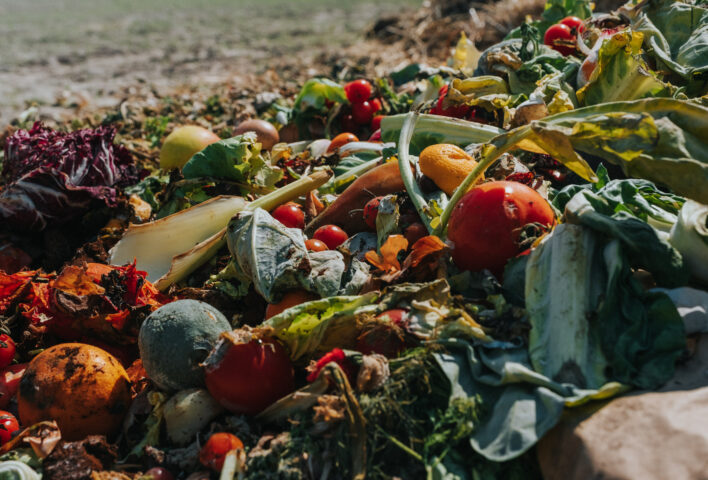Let's talk food waste

We take a look at the lay of the land (fill), plus what’s being done on both a corporate and consumer level to tackle the UK’s alarming levels of food waste.
Words: Kayleigh Rattle
When it comes to food waste, the statistics make for some pretty shocking reading. According to Food AWARE, 18 million tonnes of food is sent to UK landfill each year. In monetary terms, that’s thought to be worth £23 billion. Faced with a cost of living crisis, the numbers are even more alarming.
So who is responsible for tackling this figure, exactly? It’s clear responsibility doesn’t solely fall to the individual, or just households alone. The charity Waste and Resources Action Programme (WRAP) estimates that while 70% of total food waste comes from households, manufacturers are still responsible for approximately 16% of food detritus, with the hospitality and food industry responsible for 12% and the retail industry responsible for 3% respectively. Alarmingly, the UN Food and Agriculture Organization reports that global food waste causes 8% of total greenhouse emissions. We take a look at what’s being done to address and reduce these alarming levels.
One man’s trash is another man’s treasure
According to statistics, food manufacturers are responsible for approximately 1.5 million tonnes of food waste annually. Natural by-products of the food production process – such as peanut shells, seed husks and fruit and vegetable peel – are of course at times inevitable, but there are thankfully plenty of brands using these by-products to not only combat food waste, but to create something innovative and new.
Take coffee, for example. It’s believed the UK consumes 98 million cups of coffee a day – in turn creating tonnes of spent coffee grounds yearly. Companies such as Biobean are working to prevent such by-products from being sent to landfill by actively recycling spent coffee grounds and transforming them into everything from food flavouring to carbon-saving biofuels.
Another industry that is actively converting spent food waste is the beauty industry, with brands extracting pigments and nutrients from discarded skins and peels of fruit and vegetables, or using ‘wonky’ or misshapen items that are not deemed worthy to sell in shops and supermarkets. One such company is high street beauty pioneer, The Body Shop, which sources Spanish broken almonds to create their Almond Milk & Honey range, as well as ‘wonky’ carrots from British farmers for their Carrot Energising Face Cleanser.
Grocery gripes
Supermarkets also play a part when it comes to creating – and also tackling – food waste. High standards, on the part of consumers and the supermarkets themselves, can find perfectly edible fruit and vegetables jettisoned before they even get to the supermarket due to not being uniform enough. And then there’s the confusion often caused by ‘use by’ and ‘best before’ dates, with many customers throwing away items that have passed the ‘best before’ day, even though it remains perfectly fine to consume.
Another by-product of food production is food packaging and food packaging waste. Whether it’s plastic-wrapped bananas, raspberries, blueberries or broccoli, it’s hard to avoid plastic when shopping in a supermarket. And ultimately, while the packaging provides freshness and ensures a longer shelf life for products, it does so with a significant cost to the environment.
Embracing imperfection
While supermarkets are arguably not yet doing enough to tackle food waste, some have introduced initiatives to combat food and packaging waste, from ‘pick-your-own’ counters to refill aisles and ‘wonky’ fruit and veg boxes and schemes. Supermarkets such as M&S, Asda and Aldi have introduced refill stations to select stores, but this still remains to be rolled out nationwide.
A supermarket doing things a bit differently is Brighton and Worthing-based HISBE (How it Should Be). This pioneering supermarket – which gives itself the moniker ‘supermarket rebel’ – stocks its shelves exclusively with products from independent and local producers, as well as brands that trade responsibly, fairly and sustainably.
Food delivery scheme Oddbox is another example of an organisation redistributing perfectly edible food that would otherwise go to waste due to not meeting strict supermarket requirements. In fact, Oddbox estimates around 25% of food waste in the UK happens on farms – more than retail, manufacturing and hospitality put together – from not meeting supermarket specifications because it is too small, wonky or unusual in colour.
Food waste champions
In the food hospitality sector – which is set to see a ban on single-use plastics in England implemented from October 2023 – there are clear food waste champions shining bright, that we can all take inspiration from.
Take REfUSE, the Durham-based café that each month intercepts approximately 12 tonnes of food that would otherwise go to waste from retailers in the North East. The food is then redistributed via the ‘pay as you feel’ community café, themes restaurant nights and ‘Waste Not’ boxes which are filled with a selection of fresh fruit and vegetables and chilled goods.
In London, Silo London, a zero-waste restaurant in Hackney, trades directly with farmers for its produce, using reusable delivery methods and choosing local ingredients to generate zero waste. The menu is seasonal and innovative, and they even have their own flour mill on site. Silo’s furniture is made from materials that would have gone to waste; the plates are made from plastic bags and the tables have been created from reconstituted food packaging. Nothing is wasted – even leftover scraps of food are composted.

How to reduce food waste at home
WRAP estimates UK householders spend £15 billion every year on food that is thrown away but could have been eaten, equating to £500 a year for the average household. Bob Andrew, New Product Development Chef at veg box delivery service Riverford, shares his tips for reducing waste in the home:
Use the whole veg: Many people aren’t aware you can use cauliflower leaves as greens and also trim the stalk into batons to add to stir-frys. The green flag-leaf on leeks can also be cooked after a thorough wash, and kale stalks can be blended to make a pesto.
Don’t discard too early: What you think is fit for the compost may be absolutely fine! Tight heads of cabbage, kale, greens and lettuce can look a bit sad after a few days, but discarding an outer layer of leaves may reveal a perfectly fine specimen. A bendy carrot that seems doomed can still find life in soups and stews.
Store wisely: Try storing root veg in brown paper bags, or as far as possible away from the oven and hobs to regulate their temperature.
Stay cool: A fridge can be a deceptively dry environment, even though many people assume it to be a damp one. Try to keep leafy green veg well-covered to stop the leaves from dehydrating or wilting too fast.
Extend shelf life: Cooking ingredients can add a few extra days of life. Soft tomatoes and peppers can be roasted and become a go-to ingredient for a quick dinner or lunch.
Use your freezer: Items like ginger, chilies and lemongrass can be grated, chopped or blitzed straight from the freezer. Green herbs and leafy veg can be chopped and frozen too, ready to be added straight into the pan.
This article was originally published in our Spring 2023 magazine.
